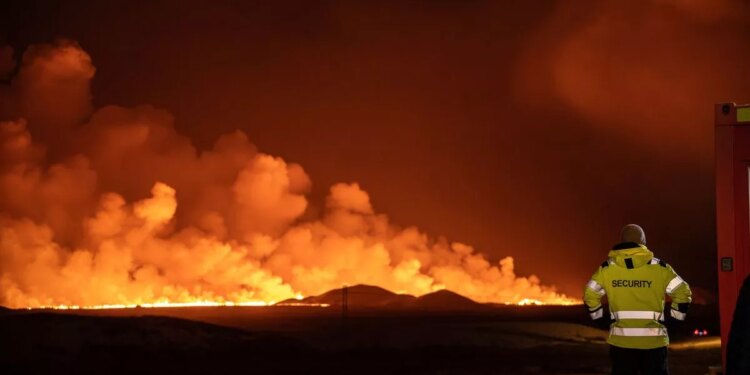Experts had previously said that this eruption would not be as disruptive as the one 13 years ago as Fagradalsfjall was not covered with ice as Eyjafjallajokull was, meaning the blast was cooled, turning the dust cloud into tiny fragments that posed a threat to aircraft. Lava from Fagradalsfjall is much more likely to remain on the ground as it currently is.
Nicola Maxey BSc (Hons), a spokesperson for the UK Met Office said: “An effusive eruption started a few km NE of Grindavík nearby Hagafell just after 10pm last night. This eruption is an effusive eruption, i.e. mainly lava and gas, and that there is no volcanic ash. At this time there is no impact on aviation. Vigorous lava fountains are clearly visible from cameras and radar images, while they reach around 500m in height they do not contain any ash.”
The volcano erupted in southwestern Iceland last night, sending a flash of light into the evening sky and spewing semi-molten rock into the air. Last night Iceland’s Foreign Minister Bjarne Benediktsson said on X, formerly Twitter, that there were no disruptions of flights to and from Iceland and international flight corridors remain open. However, this morning there have been some delays.
The November evacuation of Grindavik meant few people were near the site of eruption when it occurred and authorities have warned others to stay away. The nearby Blue Lagoon geothermal spa – one of Iceland’s biggest tourist attractions – also closed temporarily that month as a swarm of earthquakes put the island nation on alert for a possible volcanic eruption.
The residents of the evacuated fishing community of 3,400 had mixed emotions as they watched the orange flames touch the dark skies. One month after the evacuation, many are still living in temporary accommodation and don’t expect to ever be able to return to live in their homes.
“The town involved might end up under the lava,” said Ael Kermarec, a French tour guide living in Iceland. “It’s amazing to see but, there’s kind of a bittersweet feeling at the moment.”
Magnus Tumi Gudmundsson, a scientist who flew over the site on Tuesday morning onboard a coast guard research flight, told RUV that he estimates twice as much lava had already spewed than the entire monthlong eruption on the peninsula this summer.
Gudmundsson said the eruption was expected to continue decreasing in intensity but that scientists have no idea how long it could last. “It can be over in a week, or it could take quite a bit longer,” he said.
The Mirror has contacted the airlines due to fly into or out of Iceland today for comment. A spokesperson for British Airways said: “Our flights are operating as planned and we continue to monitor the situation closely.”
Source link : https://www.mirror.co.uk/travel/europe/iceland-volcano-erupts-causing-travel-31705748.amp
Author :
Publish date : 2023-12-19 08:00:00
Copyright for syndicated content belongs to the linked Source.


